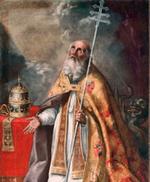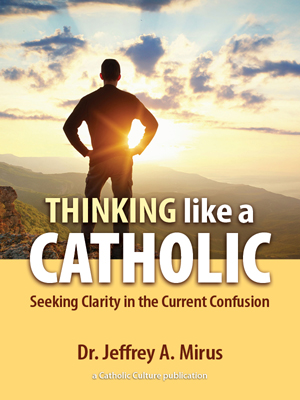Catholic Activity: The Feast of Candlemas and Its Customs
A discussion of the traditions and liturgy of Candlemas or the feast of the Presentation of the Lord (previously called the Purification of Mary).
From the Handbook of Christians Feasts and Customs by Francis X. Weiser, S.J.
DIRECTIONS
CANDLEMAS
HISTORY — The Law of Moses prescribed that every Jewish mother after giving birth to a boy child was to be excluded from attendance at public worship for forty days. At the end of that period she had to present a yearling lamb for a holocaust and a pigeon for sin offering, thus purifying herself from ritual uncleanliness. In the case of poor people, two pigeons sufficed as an offering (Leviticus 12, 2-8). The Gospel reports how Mary, after the birth of Jesus, fulfilled this command of the law, and how on the same occasion Simeon and Anna met the newborn Saviour (Luke 2, 22-38).
Since Christ Himself was present at this event, it came to be celebrated quite early as a festival of the Lord. The first historical description of the feast is given in the diary of Aetheria (about 390). She mentioned that the services in Jerusalem began with a solemn procession in the morning, followed by a sermon on the Gospel text of the day, and finally Mass was offered. At that time the festival was kept on February 14, because the birth of Christ was celebrated on the Feast of the Epiphany (January 6). It had no special name but was called "the fortieth day after Epiphany."1
From Jerusalem the feast spread into the other churches of the Orient. The Armenians call it the "Coming of the Son of God into the Temple" and still celebrate it on February 14.2 In the Coptic (Egyptian) Rite it is termed "Presentation of the Lord in the Temple."3 East Roman Emperor Justinian I in 542 prescribed it for the whole country as a public holyday, in thanksgiving for the end of a great pestilence. By that time it was known in the Greek Church under the title Hypapante Kyriou (The Meeting of the Lord), in commemoration of Christ's meeting with Simeon and Anna.4
According to the Gospel, Simeon, holding the Child in his arms, said, "Now doest thou dismiss thy servant, o Lord...." The word "now" prompted the Christians of the Orient to believe that Simeon, having seen the Saviour, died on the same day. Thus they made Candlemas also the annual feast of Simeon. Hence the Chaldeans and Syrians even today call the festival 'id Sham'oun al-Shaikh (Feast of Simeon the Old Man).
In the Western Church the commemoration of this event appeared first in the liturgical books (Gelasianum, Gregorianum) of the seventh and eighth centuries. It bore the title "Purification of Mary" and was listed for February 2 (forty days after Christmas).5
It was Pope Sergius I (701) who prescribed the procession with candles, not only for the Feast of the Purification, but also for the other three feasts of Mary which were then annually celebrated in Rome (Annunciation, Assumption, Nativity of Mary). The procession was first instituted as a penitentiary rite with prayers (litaniae) imploring God's mercy; hence the Church uses the penitential color (purple) even now for the blessing of candles and for the procession.6
Some scholars explain these light processions on the feasts of Mary in Rome as a Christian substitute for the ancient popular torch parades at various times of the year.7 In this case the Candlemas procession would have replaced the light parades of the Lupercalia, a pagan feast celebrated on February 14 and 15.8 Other scholars, however, claim that there is no historical connection between the Christian processions and pagan parades, for the festival of Mary's purification was never kept on February 14 in the Western Church; moreover, there was no procession of lights in the beginning, and the pagan custom of the Lupercalia had been discontinued three hundred years before the procession was inaugurated.9
The original rite of Pope Sergius did not provide for any blessing of candles. The celebrant in those early centuries distributed to the clergy, for the procession, candles that were neither blessed nor lighted. The ceremony of blessing originated at the end of the eighth century in the Carolingian Empire, as did most of the other liturgical blessings (of Easter fire, Easter water, palms).10
LITURGY — In present liturgical usage the officiating priest blesses the candles before the Mass. He sings or recites five prayers of blessing. The following excerpts show the intention and purpose for which this blessing is bestowed by the Church:
...We humbly implore thee [o God] through the invocation of thy holy name and through the intercession of Mary, ever Virgin, whose feast we devoutly celebrate today, also through the prayers of all thy saints: Deign to bless and sanctify these candles for human use, for the welfare of body and soul both on land and on water. These thy servants desire to carry them in their hands while they praise thee with their hymns: Hear their voices graciously from thy holy Heaven and from the throne of thy majesty; be merciful to all who cry to thee, whom thou hast redeemed by the precious blood of thy Son, who lives and reigns with thee, God for ever and ever. Amen.Lord Jesus Christ, true light that enlightens every man who comes into this world, bestow thy blessing upon these candles, and sanctify them with the light of thy grace. As these tapers burn with visible fire and dispel the darkness of night, so may our hearts with the help of thy grace be enlightened by the invisible fire of the splendor of the Holy Ghost, and may be free from all blindness of sin. Clarify the eyes of our minds that we may see what is pleasing to thee and conducive to our salvation. After the dark perils of this life let us be worthy to reach the eternal light. Through thee, Jesus Christ, Savior of the world, who in perfect Trinity livest and reignest, God, for ever and ever. Amen.11
After the blessing the celebrant distributes the candles to the clergy and faithful, who carry them in their hands during the solemn procession. Meanwhile, the choir sings the canticle of Simeon, Nunc Dimittis (Luke 2, 29-32), and various antiphons. The symbolism of the light procession is obvious from the antiphon that is repeated after every verse of the canticle, Lumen ad revelationem gentium (a light of revelation to the gentiles). It represents Christ, the Light of the World, at His presentation in the temple of Jerusalem.
The procession is always held on February 2, even when the Mass and Office are transferred to another day. In most places it is now held inside the church, but in past centuries the clergy used to proceed into the open and walk through the churchyard past the graves of departed parishioners.12
NAMES — From the blessing of candles and the procession of lights come the names of the feast in most countries: Candlemas (English), Lichtmess (German), Candelas (Spanish), Candelora (Italian), Chandeleur (French), Hromnice (Feast of Candles, among the Slovaks and Czechs), Svijetlo Marijino (Light Feast of Mary, in Yugoslavia). The Slavs of the Eastern Rite (Russians, Ukrainians) call it "Meeting of the Lord" (Stretenije Gospoda).13
FOLKLORE — In some countries the faithful use large and adorned candles, which they bring along for the blessing. Among the Syrians and Chaldeans the sexton of the parish church prepares these candles, which are made of unbleached wax and painted with designs of gold. In central and eastern Europe people bring candles and tapers of various colors, decorated with flower motifs, holy pictures, and liturgical symbols. After the blessing they take them home and keep them all through the year as cherished sacramentals, to be lighted during storms and lightning, in sickrooms, and at the bedside of dying persons.14
The Poles have a beautiful legend that Mary, the "Mother of God of the Blessed Thunder Candle" (Matka Boska Gromniczna), watches on wintry nights around Candlemas, when hungry wolves are on rampage outside the sleeping village. With her thunder candle she wards off the ravenous pack and protects the peasants from all harm.
In ancient times the tenant farmers had to pay their rent at Candlemas. After this disagreeable task they were entertained by the landlord with a sumptuous banquet. Candlemas is also the term day for rural laborers in most countries of central Europe and in England. Both farm hands and maids who have hired themselves out for the coming season move in with their new masters and begin work on February 3.15
All over Europe Candlemas was considered one of the great days of weather forecasting. Popular belief claims that bad weather and cloudy skies on February 2 mean an early and prosperous summer. If the sun shines through the greater part of Candlemas Day, there will be at least forty more days of cold and snow. This superstition is familiar to all in our famous story of the ground hog looking for his shadow on Candlemas Day.16
In rural sections of Austria it is held an omen of blessing and good luck if the sun breaks through the cloudy skies for just a few minutes to cast its radiant glow over the earth. Children wait for this moment and greet the appearance of the sunlight with little songs like this one from the province of Vorarlberg:
Hail, glorious herald, holy light,
God sends you from His Heaven bright.
Your cheerful glow and golden rays
May bring us happy summer days.
Lead us through earthly toil and strife
To everlasting light and life.17
Finally, Candlemas Day used to be, and still is in many countries, the end of the popular Christmas season. Cribs and decorations are taken down with care and stored away for the following Christmas season. The Christmas plants are burned, together with the remnants of the Yule log, and the ashes are strewn over garden and fields to insure wholesome and healthy growth for the coming spring.18
LITURGICAL PRAYER — Almighty and eternal God, we humbly beseech Thy majesty: as Thy only-begotten Son was presented in the temple this day in the substance of our flesh, so let us be presented unto Thee with cleansed souls.
Activity Source: Handbook of Christian Feasts and Customs by Francis X. Weiser, S.J., Harcourt, Brace and Company, New York, 1958






